Can glacial rock flour from Greenland increase global food production and efficiently bind atmospheric CO2 in the field at the same time?

It’s actually a pretty wild idea. Imagine large supertankers loaded with glacial rock flour dug out of Greenlandic fjords. The fjords are continuously fed with new fine rock flour pushed out under the large glaciers into the ocean. When the large ships are fully loaded, the rock flour is transported and applied to agricultural fields around the World. Once on the field, it provides important plant nutrients while also capturing CO2 from the atmosphere. In this way, we may be able to increase food production and mitigate climate change at the same time”
Before this scenario can be realized, a range of experiments are needed to test how much rock flour is needed for different soil types under different climatic conditions, to make it worthwhile the effort of excavating and moving large amounts of rock flour minerals thousands of kilometers around the globe.
Scientists from Department of Geosciences and Natural Resource Management (IGN) participate in the project with their expertise on measuring the exchange of greenhouse gases between the ecosystem and atmosphere. Professor Minik Rosing from the Globe Institute leads the new Center. In addition to IGN, scientists from Department of Biology (BIO) and Department of Plant Sciences (PLEN) at University of Copenhagen participate in the Center activities, as well as a number of international researchers, who run similar experimental field trials in Australia and Ghana.
The Greenlandic rock flour has a high content of silicate minerals (Si-O compounds), which weathers in a reaction with carbonic acid (H2CO3). As part of the reaction, CO2 is captured from the atmosphere. In addition, the weathering process releases nutrients such as Potassium (K), Magnesium (Mg) and Silicon (Si) into the soil, contributing to increased plant growth and harvest yields. There may be additional positive effects of adding rock flour to soils, such as improved soil nutrient and water retention. These aspects will also be investigated in the ongoing experiments.

On the experimental fields at Højbakkegård near Taastrup the scientists investigate how the plant and soil exchange of greenhouse gases (CO2, CH4 and N2O) change when the Greenlandic rock flour is added to the field at different levels of concentration.
The automatic chambers measure the greenhouse gas exchange every two hours continuously day and night. The results will help the scientists determine the optimal concentration of application of the rock flour for maximizing the benefits in terms of increased crop yield and CO2 uptake.
(Photos and video: Klaus Steenberg Larsen).
Funded by

Centre for Glacial Rock Flour Research has received five-year funding from the Novo Nordisk Foundation
Project: Centre for Glacial Rock Flour Research
Project period: 2022-2027.
